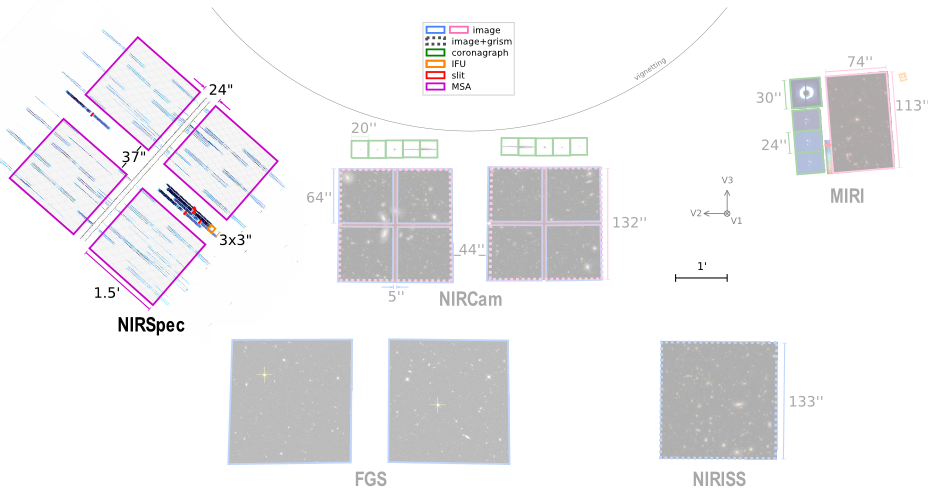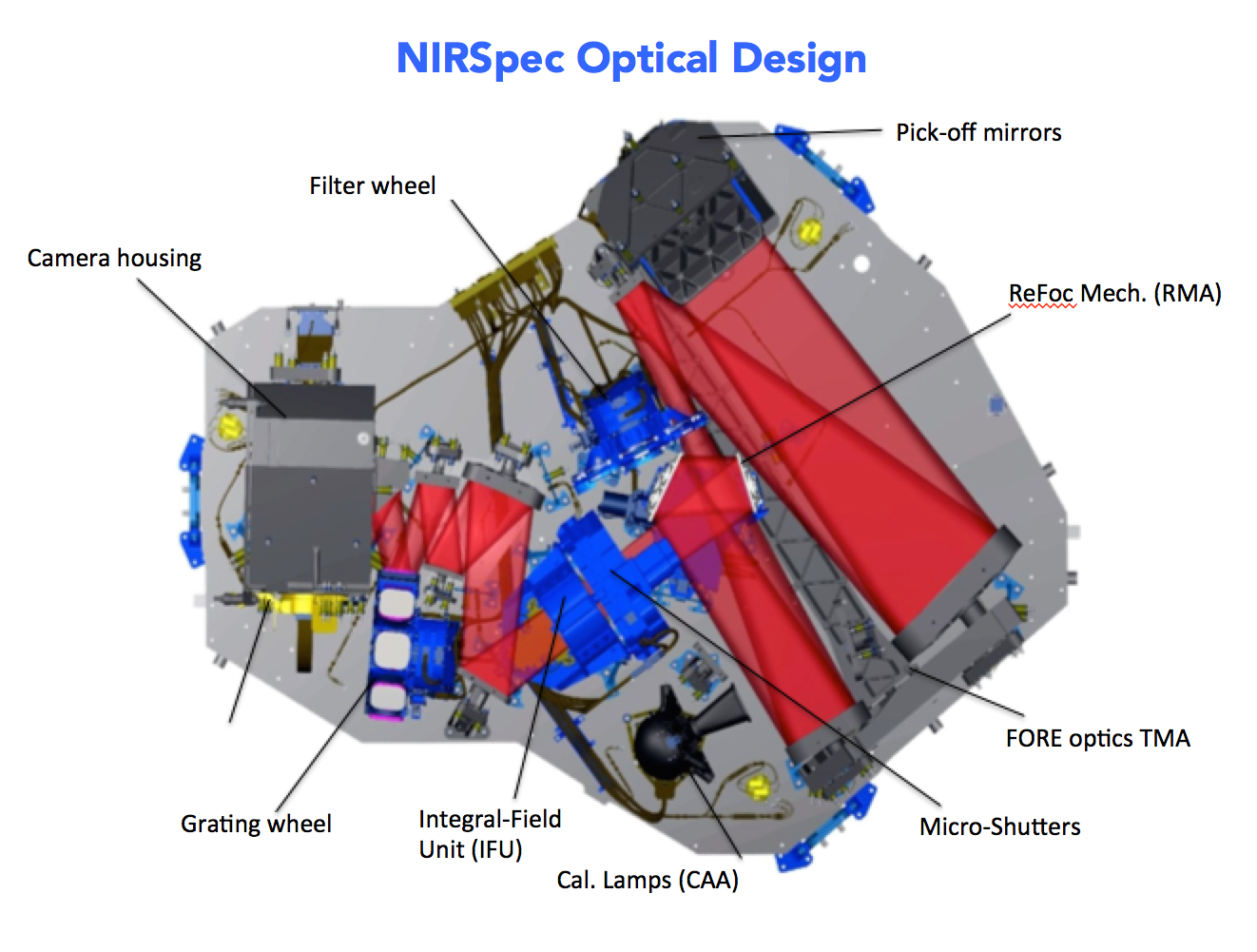JWST Near Infrared Spectrograph
The JWST Near Infrared Spectrograph (NIRSpec) provides near-IR spectroscopy from 0.6–5.3 μm within a 3.4 × 3.6 arcmin field of view using a micro-shutter assembly (MSA), an integral field unit (IFU), and fixed slits (FSs).
On this page
The JWST Near Infrared Spectrograph (NIRSpec) enables 0.6–5.3 μm spectroscopy at resolving powers of ~100, ~1,000, and ~2,700 in 4 observing modes. NIRSpec is designed to be particularly powerful for multiplexing spectroscopy and high contrast, high throughput single-object spectroscopy.
Key science uses of NIRSpec include, but are not limited to: statistical survey spectroscopy for galaxy formation and evolution studies, characterization of stellar populations, spatially resolved spectroscopy of extended targets, and characterization of exoplanet atmospheres using transit observations.
The 4 observing modes of NIRSpec are:
- Multi-object spectroscopy (MOS) with the micro-shutter assembly (MSA)
- Imaging spectroscopy with the integral field unit (IFU)
- High contrast single object spectroscopy with the fixed slits (FSs)
- High throughput bright object time-series (BOTS) spectroscopy with the NIRSpec wide aperture
Each NIRSpec mode has its own planning interface template in the Astronomer's Proposal Tool (APT) software. Follow the links below to access the documentation for each of the observing modes:
- NIRSpec MOS planning in APT
- NIRSpec IFU planning in APT
- NIRSpec fixed slit planning in APT
- NIRSpec bright object time-series planning in APT
Information about calibration is available at JWST Calibration Status. This article and its links point to content about absolute astrometric, flux, and wavelength calibration, as well as information on calibration reference files.
Details about the data can be found in the JWST Science Data Overview article. The JWST pipeline is described in JWST Science Calibration Pipeline and some information about post-pipeline processing can be found at JWST Post-Pipeline Data Analysis.
Observational capabilities
As noted above, NIRSpec offers 4 different modes. Table 1 summarizes these modes including wavelength coverages, aperture sizes and average (central wavelength) resolving powers.
Table 1. Characteristics of NIRSpec oberving modes
| Observing mode | Aperture or slit size (arcsec) | Wavelength coverage (μm) | Pixel scale (arcsec/pixel) | Resolving power† |
|---|---|---|---|---|
| MSA spectroscopy | 0.20 × 0.46 | 0.6–5.3 μm (prism) 0.7–1.27 μm (f070lp) 0.97–1.89 μm (f100lp) 1.66–3.17 μm (f170lp) 2.87–5.27 μm (f295lp) | 0.1 |
~100 (Prism), ~1,000 (medium-resolution gratings), ~2,700 (high-resolution gratings) |
| IFU spectroscopy | 3.0 × 3.0 | |||
| Fixed slit spectroscopy | 0.2 × 3.2 0.4 × 3.65 1.6 × 1.6 | |||
| Bright object time series | 1.6 × 1.6 |
† These resolving powers correspond to the values at the central wavelength in the measured spectral range.
†† Multiple shutters can be combined to form a slit.
Optical elements and detectors
See also: NIRSpec Optics, NIRSpec Detectors
Figure 2 shows the NIRSpec optical design. The key instrument elements that are important for science observation specifications are the filters, dispersers, science apertures, and detectors.
Filter wheel assembly (FWA)
NIRSpec has a filter wheel equipped with:
- four long-pass filters and a clear filter for spectroscopy and target acquisition,
- two short wavelength filters that can be used for target acquisition, and
- an opaque blocking filter used to block the light entering NIRSpec when the instrument is not in use.
Grating wheel assembly (GWA)
The NIRSpec grating wheel assembly has a low resolution (R ~ 100) prism, 3 medium resolution (R ~ 1,000) gratings, 3 high resolution (R ~ 2,700) gratings, and a mirror for target acquisition imaging.
Apertures
NIRSpec has 3 types of apertures; they are MSA shutters, integral field unit (IFU), and fixed slits (FSs).
- Multi-object spectroscopy (MOS) with the MSA: NIRSpec MOS capabilities are enabled by the micro-shutter assembly, which is a 4-quadrant grid of individually configurable shutters, each 0.20" × 0.46" in extent on the sky.
- IFU spectroscopy: NIRSpec's integral field spectroscopy mode is enabled by the IFU to acquire three-dimensional (2D spatial plus 1D spectral) imaging spectroscopy over a small 3" × 3" field of view with 0.1" sampling.
- Fixed slits spectroscopy: Five fixed slits are available for high-contrast spectroscopy on single objects. One of these slits is a 1.6" × 1.6" aperture that has been optimized for exoplanet transit observations in the bright object time-series spectroscopy mode.
Detectors
NIRSpec's focal plane is equipped with two 5.3 μm cutoff Teledyne-Hawaii-2RG HgCdTe arrays, each having 2048 × 2048 pixels.
- The projected detector pixel size on the sky is 0.1".
- There is a physical gap between the detectors which can result in wavelength loss in a single NIRSpec exposure in the MOS mode, and in the R = 2,700 resolution gratings in all science modes.
- In order to meet instrument sensitivity requirements, NIRSpec has a specialized low noise readout mode called "increased reference sampling and subtraction (IRS2)," which intersperses more reference pixel reads to better remove noise effects.
Sensitivity and performance
The NIRSpec sensitivity and performance has been determined from on-orbit data collection during the JWST instrument commissioning phase of the mission (Böker, Beck, Birkmann, 2023) and will continue during Cycle 1. Updates to sensitivity and performance will be included in JDox articles as it becomes available. Information about the current status of NIRSpec sensitivity and performance can be found in these articles: NIRSpec Performance, NIRSpec Bright Source Limits, and NIRSpec Sensitivity.
Observers testing NIRSpec performance and preparing proposals should always use the JWST Exposure Time Calculator (ETC) to obtain the most recent sensitivity estimates.
Data calibration and analysis
Information about calibration is available at JWST Calibration Status. This article and its links point to content about absolute astrometric, flux, and wavelength calibration, as well as information on calibration reference files.
Details about the data can be found in the JWST Science Data Overview article. The JWST pipeline is described in JWST Science Calibration Pipeline and some information about post-pipeline processing can be found at JWST Post-Pipeline Data Analysis.
Proposal planning
See also: NIRSpec APT Templates
Each mode in NIRSpec has its own planning interface template in the Astronomer's Proposal Tool (APT) software. Follow the links below to access the documentation for each of the observing modes:
- NIRSpec IFU planning in APT
- NIRSpec fixed slit planning in APT
- NIRSpec bright object time series planning in APT
- NIRSpec MOS planning in APT
There are many helpful videos that can found below.
NIRSpec links and documents
External documents, pre-launch predicted performance
Birkmann, S. M., Ferruit, P., Giardino, G. et al. 2022, A&A, 661, A83
The Near-Infrared Spectrograph (NIRSpec) on the James Webb Space Telescope. IV. Capabilities and predicted performance for exoplanet characterization
Böker, T., Arribas, S., Lützgendorf, N. et al. 2022, A&A, 661, A82
The Near-Infrared Spectrograph (NIRSpec) on the James Webb Space Telescope. III. Integral-field spectroscopy
Ferruit, P., Jakobsen, P., Giardino, G. et al. 2022, A&A, 661, A81
The Near-Infrared Spectrograph (NIRSpec) on the James Webb Space Telescope. II. Multi-object spectroscopy (MOS)
Jakobsen, P., Ferruit, P., Alves de Oliveira, C. et al. 2022, A&A, 661, A80
The Near-Infrared Spectrograph (NIRSpec) on the James Webb Space Telescope. I. Overview of the instrument and its capabilities
External documents, on-orbit measured performance
Alves de Oliveira, C., Lützgendorf, N., Zeidler, P., et al., 2022 Proc. SPIE, 12180, 121803S (arXiv:2208.05354)
In-flight performance and calibration of the grating wheel assembly sensors (NIRSpec/JWST)
Birkmann, S.M., Giardino, G., Sirianni, M., et al., 2022, Proc. SPIE, 12180, 121802P (arXiv:2208.12686)
The in-flight noise performance of the JWST/NIRSpec detector system
Böker, T., Abul-Huda, Y., Altenburg, M., et al. 2022, Proc. SPIE, 12180, 121800W (arXiv:2208.02860)
In-orbit Commissioning of the Near-Infrared Spectrograph on the James Webb Space Telescope
Böker, T., Beck, T.L., Birkmann, S.M., et al. 2023, PASP, 135, 038001 (arXiv:2301.13766)
In-orbit Performance of the Near-infrared Spectrograph NIRSpec on the James Webb Space Telescope
Giardino, G., Bhatawdekar, R., Birkmann, S.M., et al. 2022, Proc. SPIE, 12180, 121800X (arXiv:2208.04876)
Optical throughput and sensitivity of the JWST NIRSpec
Lützgendorf, N., Giardino, G., Alves de Oliveira, C., et al. 2022, Proc. SPIE, 12180, 121800Y (arXiv:2208.05355)
Astrometric and wavelength calibration of the NIRSpec instrument during commissioning using a model-based approach
Rawle, T.D., Giardino, G., Franz, D.E., et al., 2022, Proc. SPIE, 12180, 121803R (arXiv:2208.04673)
In-flight performance of the NIRSpec micro shutter array
Rigby, J., Perrin, M., McElwain, M., et al. 2023, PASP, 135, 048001 (arXiv:2207.05632)
The Science Performance of JWST as Characterized in Commissioning
Links to additional information
Acknowledgements
NIRSpec was built for the European Space Agency by Airbus Industries; the micro-shutter assembly and detector subsystems were provided by NASA. Dr. Peter Jakobsen guided NIRSpec's development until his retirement in 2011. Dr. Pierre Ferruit is the current NIRSpec PI and ESA JWST project scientist.
References
Böker, T., Beck, T.L., Birkmann, S.M., et al. 2023, PASP, 135, 038001 and arXiv:2301.13766
In-orbit Performance of the Near-infrared Spectrograph NIRSpec on the James Webb Space Telescope
Jakobsen, P., Ferruit, P., Alves de Oliveira, C. et al. 2022, A&A, 661, A80
The Near-Infrared Spectrograph (NIRSpec) on the James Webb Space Telescope. I. Overview of the instrument and its capabilities


